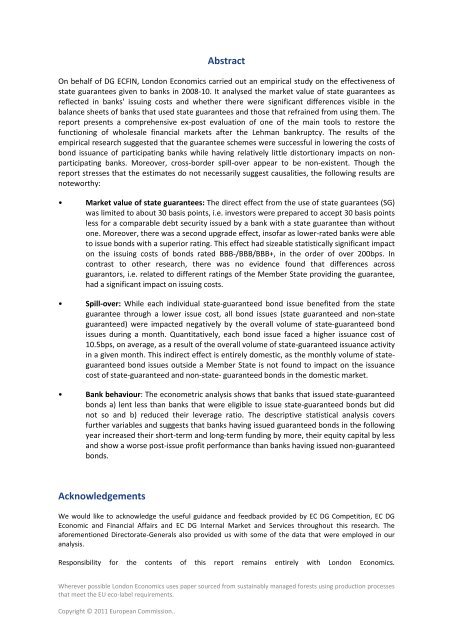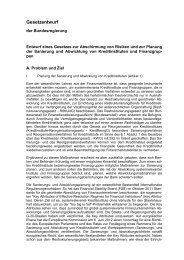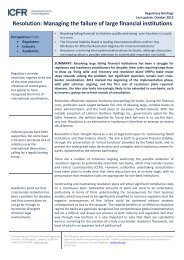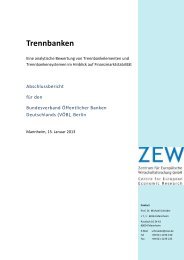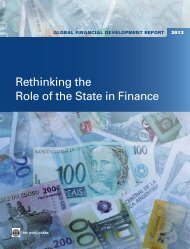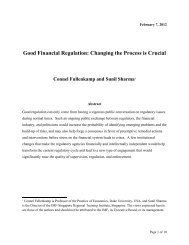3 Issuing costs of state guaranteed bonds - Financial Risk and ...
3 Issuing costs of state guaranteed bonds - Financial Risk and ...
3 Issuing costs of state guaranteed bonds - Financial Risk and ...
Create successful ePaper yourself
Turn your PDF publications into a flip-book with our unique Google optimized e-Paper software.
Wherever possible London Economics uses paper sourced from sustainably managed forests using production processes<br />
that meet the EU eco-label requirements.<br />
Copyright © 2011 European Commission..<br />
Abstract<br />
On behalf <strong>of</strong> DG ECFIN, London Economics carried out an empirical study on the effectiveness <strong>of</strong><br />
<strong>state</strong> guarantees given to banks in 2008-10. It analysed the market value <strong>of</strong> <strong>state</strong> guarantees as<br />
reflected in banks' issuing <strong>costs</strong> <strong>and</strong> whether there were significant differences visible in the<br />
balance sheets <strong>of</strong> banks that used <strong>state</strong> guarantees <strong>and</strong> those that refrained from using them. The<br />
report presents a comprehensive ex-post evaluation <strong>of</strong> one <strong>of</strong> the main tools to restore the<br />
functioning <strong>of</strong> wholesale financial markets after the Lehman bankruptcy. The results <strong>of</strong> the<br />
empirical research suggested that the guarantee schemes were successful in lowering the <strong>costs</strong> <strong>of</strong><br />
bond issuance <strong>of</strong> participating banks while having relatively little distortionary impacts on nonparticipating<br />
banks. Moreover, cross-border spill-over appear to be non-existent. Though the<br />
report stresses that the estimates do not necessarily suggest causalities, the following results are<br />
noteworthy:<br />
Market value <strong>of</strong> <strong>state</strong> guarantees: The direct effect from the use <strong>of</strong> <strong>state</strong> guarantees (SG)<br />
was limited to about 30 basis points, i.e. investors were prepared to accept 30 basis points<br />
less for a comparable debt security issued by a bank with a <strong>state</strong> guarantee than without<br />
one. Moreover, there was a second upgrade effect, ins<strong>of</strong>ar as lower-rated banks were able<br />
to issue <strong>bonds</strong> with a superior rating. This effect had sizeable statistically significant impact<br />
on the issuing <strong>costs</strong> <strong>of</strong> <strong>bonds</strong> rated BBB-/BBB/BBB+, in the order <strong>of</strong> over 200bps. In<br />
contrast to other research, there was no evidence found that differences across<br />
guarantors, i.e. related to different ratings <strong>of</strong> the Member State providing the guarantee,<br />
had a significant impact on issuing <strong>costs</strong>.<br />
Spill-over: While each individual <strong>state</strong>-<strong>guaranteed</strong> bond issue benefited from the <strong>state</strong><br />
guarantee through a lower issue cost, all bond issues (<strong>state</strong> <strong>guaranteed</strong> <strong>and</strong> non-<strong>state</strong><br />
<strong>guaranteed</strong>) were impacted negatively by the overall volume <strong>of</strong> <strong>state</strong>-<strong>guaranteed</strong> bond<br />
issues during a month. Quantitatively, each bond issue faced a higher issuance cost <strong>of</strong><br />
10.5bps, on average, as a result <strong>of</strong> the overall volume <strong>of</strong> <strong>state</strong>-<strong>guaranteed</strong> issuance activity<br />
in a given month. This indirect effect is entirely domestic, as the monthly volume <strong>of</strong> <strong>state</strong><strong>guaranteed</strong><br />
bond issues outside a Member State is not found to impact on the issuance<br />
cost <strong>of</strong> <strong>state</strong>-<strong>guaranteed</strong> <strong>and</strong> non-<strong>state</strong>- <strong>guaranteed</strong> <strong>bonds</strong> in the domestic market.<br />
Bank behaviour: The econometric analysis shows that banks that issued <strong>state</strong>-<strong>guaranteed</strong><br />
<strong>bonds</strong> a) lent less than banks that were eligible to issue <strong>state</strong>-<strong>guaranteed</strong> <strong>bonds</strong> but did<br />
not so <strong>and</strong> b) reduced their leverage ratio. The descriptive statistical analysis covers<br />
further variables <strong>and</strong> suggests that banks having issued <strong>guaranteed</strong> <strong>bonds</strong> in the following<br />
year increased their short-term <strong>and</strong> long-term funding by more, their equity capital by less<br />
<strong>and</strong> show a worse post-issue pr<strong>of</strong>it performance than banks having issued non-<strong>guaranteed</strong><br />
<strong>bonds</strong>.<br />
Acknowledgements<br />
We would like to acknowledge the useful guidance <strong>and</strong> feedback provided by EC DG Competition, EC DG<br />
Economic <strong>and</strong> <strong>Financial</strong> Affairs <strong>and</strong> EC DG Internal Market <strong>and</strong> Services throughout this research. The<br />
aforementioned Directorate-Generals also provided us with some <strong>of</strong> the data that were employed in our<br />
analysis.<br />
Responsibility for the contents <strong>of</strong> this report remains entirely with London Economics.


